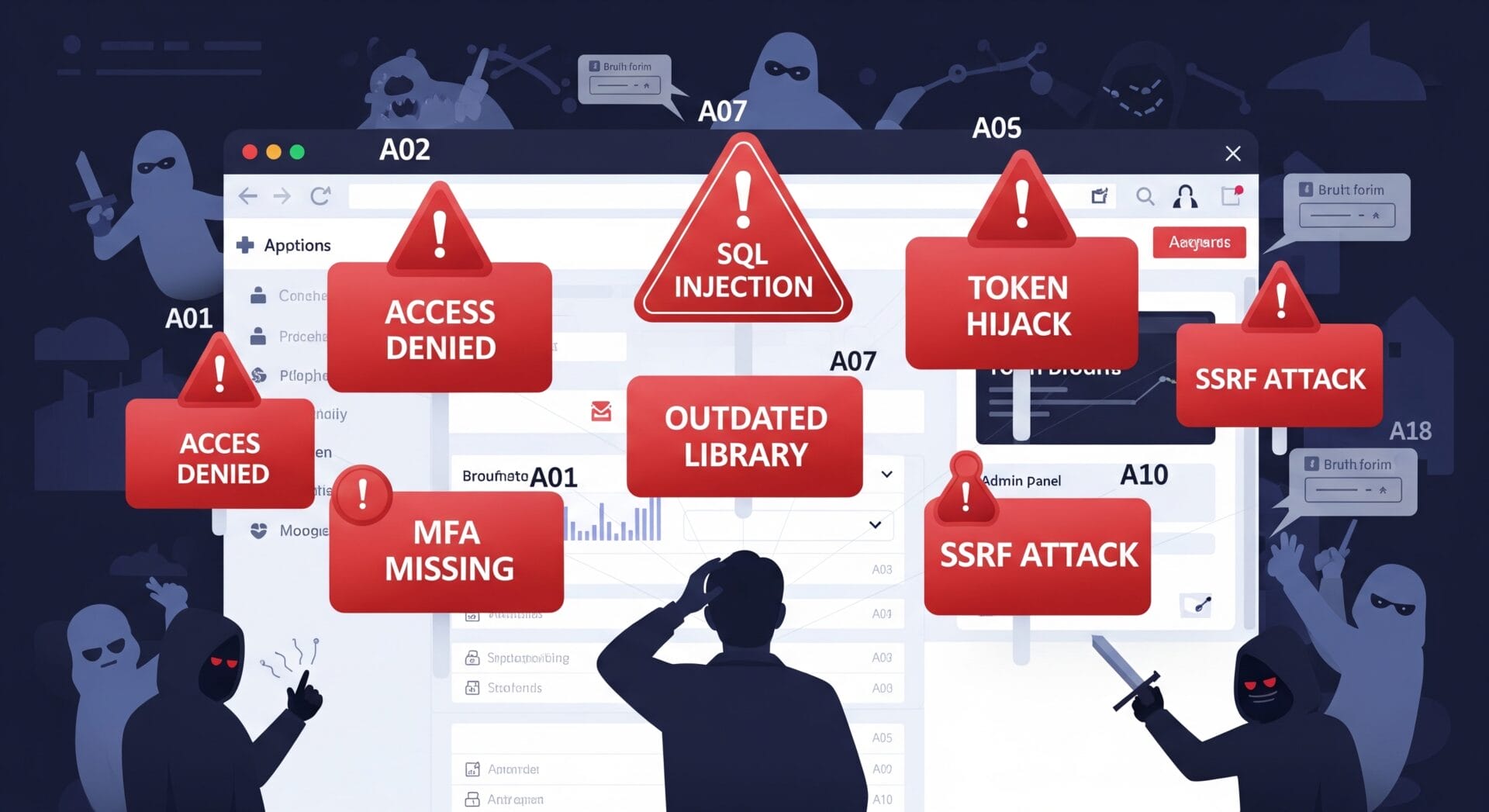As a frontend developer, you might think backend is where most security battles are fought. But in today’s interconnected world, a vulnerable front door is all an attacker needs. Understanding OWASP’s Top 10 security risks isn’t just backend stuff it’s crucial knowledge for all developers, especially those building single-page apps (SPAs) or integrating with APIs.
In this blog, we’ll walk through all 10 security risks using one consistent example: a fictional SaaS platform called DevSync, a project management tool used by thousands of developers globally. We’ll explain each OWASP category with practical frontend-focused context and real-world breaches.

Risk: Users can access functionality or data they shouldn’t.
Example in DevSync: A frontend dev exposes the /admin route in the React Router thinking “only admins will see this anyway.” But the route isn’t protected on the backend so any logged-in user who manually navigates to /admin can access user management features.
Real Attack Parallel: GitHub once had a vulnerability allowing users to add SSH keys to other accounts by manipulating API requests.
Risk: Sensitive data is sent or stored without proper encryption.
Example in DevSync: The frontend fetches user profile info over HTTP instead of HTTPS on a coffee shop Wi-Fi, an attacker intercepts the traffic and grabs tokens and emails.
Real Attack Parallel: Equifax’s 2017 breach involved unencrypted sensitive data (among other flaws), exposing millions of SSNs.
Risk: Malicious input is interpreted as code.
Example in DevSync: A search bar in the frontend sends queries directly to an API that constructs a SQL query like:
SELECT * FROM projects WHERE name LIKE ‘%${search}%’
An attacker types ‘ OR ‘1’=’1 and now they get access to all projects.
Real Attack Parallel: The 2008 Heartland breach leaked 100M+ credit cards using SQL injection.
Risk: Poorly thought-through security design that can’t be fixed by patches.
Example in DevSync: Devs allow unlimited password resets without cooldown or CAPTCHA. Attackers abuse this to spam users or brute-force reset links.
Risk: Insecure default settings, error leaks, unnecessary features.
Example in DevSync: The app runs in development mode with detailed error messages. When a frontend request fails, the API responds with a full stack trace revealing file paths and dependencies.
Real Attack Parallel: Verizon’s 2017 breach was worsened by misconfigured S3 buckets exposing data.
Risk: Using libraries with known exploits.
Example in DevSync: The frontend uses an outdated version of lodash with a prototype pollution vulnerability. An attacker sends a payload that corrupts object properties, leading to privilege escalation.
Real Attack Parallel: Event-Stream NPM package was backdoored to steal Bitcoin wallets.
Risk: Weak login, poor session handling, missing 2FA.
Example in DevSync: After login, a JWT token is stored in localStorage. On public Wi-Fi, an attacker uses a packet sniffer and grabs the token now they can impersonate the user.
Real Attack Parallel: Twitter (2020) attackers used social engineering and weak controls to hijack verified accounts.
Risk: Trusting components or data without verification.
Example in DevSync: Frontend loads a third-party script (analytics.js) over HTTP from an unknown CDN. One day, that file is replaced with malicious JS that logs keystrokes.
Real Attack Parallel: The SolarWinds hack inserted malicious updates into trusted software.
Risk: You don’t know when you’re under attack.
Example in DevSync: A user gets 100 login failures in 2 minutes no alert, no logs, no rate limiting. The attacker eventually succeeds.
Real Attack Parallel: Capital One’s 2019 breach involved missing alert triggers that allowed massive data exfiltration to go unnoticed.
Risk: Server fetches malicious URLs.
Example in DevSync: The frontend allows users to upload images by URL. It sends that URL to the backend for validation. But attackers submit http://localhost:8000/internal-config, letting the backend leak sensitive internal data.
Real Attack Parallel: The 2019 Capital One breach used SSRF to access AWS metadata services.

Modern web apps especially those built with React, Vue, Angular, etc. are powerful, but they must be secure by design. As a frontend developer, you’re not just writing UI you’re the first line of defense against many of these threats.
Even seemingly small decisions where you store tokens, how you render admin-only routes, how you handle inputs can open the door to massive security incidents.

We worked with Mindbowser on a design sprint, and their team did an awesome job. They really helped us shape the look and feel of our web app and gave us a clean, thoughtful design that our build team could...


The team at Mindbowser was highly professional, patient, and collaborative throughout our engagement. They struck the right balance between offering guidance and taking direction, which made the development process smooth. Although our project wasn’t related to healthcare, we clearly benefited...

Founder, Texas Ranch Security

Mindbowser played a crucial role in helping us bring everything together into a unified, cohesive product. Their commitment to industry-standard coding practices made an enormous difference, allowing developers to seamlessly transition in and out of the project without any confusion....

CEO, MarketsAI

I'm thrilled to be partnering with Mindbowser on our journey with TravelRite. The collaboration has been exceptional, and I’m truly grateful for the dedication and expertise the team has brought to the development process. Their commitment to our mission is...

Founder & CEO, TravelRite

The Mindbowser team's professionalism consistently impressed me. Their commitment to quality shone through in every aspect of the project. They truly went the extra mile, ensuring they understood our needs perfectly and were always willing to invest the time to...

CTO, New Day Therapeutics

I collaborated with Mindbowser for several years on a complex SaaS platform project. They took over a partially completed project and successfully transformed it into a fully functional and robust platform. Throughout the entire process, the quality of their work...

President, E.B. Carlson

Mindbowser and team are professional, talented and very responsive. They got us through a challenging situation with our IOT product successfully. They will be our go to dev team going forward.

Founder, Cascada

Amazing team to work with. Very responsive and very skilled in both front and backend engineering. Looking forward to our next project together.

Co-Founder, Emerge

The team is great to work with. Very professional, on task, and efficient.

Founder, PeriopMD

I can not express enough how pleased we are with the whole team. From the first call and meeting, they took our vision and ran with it. Communication was easy and everyone was flexible to our schedule. I’m excited to...

Founder, Seeke

We had very close go live timeline and Mindbowser team got us live a month before.

CEO, BuyNow WorldWide

Mindbowser brought in a team of skilled developers who were easy to work with and deeply committed to the project. If you're looking for reliable, high-quality development support, I’d absolutely recommend them.

Founder, Teach Reach

Mindbowser built both iOS and Android apps for Mindworks, that have stood the test of time. 5 years later they still function quite beautifully. Their team always met their objectives and I'm very happy with the end result. Thank you!

Founder, Mindworks

Mindbowser has delivered a much better quality product than our previous tech vendors. Our product is stable and passed Well Architected Framework Review from AWS.

CEO, PurpleAnt

I am happy to share that we got USD 10k in cloud credits courtesy of our friends at Mindbowser. Thank you Pravin and Ayush, this means a lot to us.

CTO, Shortlist

Mindbowser is one of the reasons that our app is successful. These guys have been a great team.

Founder & CEO, MangoMirror

Kudos for all your hard work and diligence on the Telehealth platform project. You made it possible.

CEO, ThriveHealth

Mindbowser helped us build an awesome iOS app to bring balance to people’s lives.

CEO, SMILINGMIND

They were a very responsive team! Extremely easy to communicate and work with!

Founder & CEO, TotTech

We’ve had very little-to-no hiccups at all—it’s been a really pleasurable experience.

Co-Founder, TEAM8s

Mindbowser was very helpful with explaining the development process and started quickly on the project.

Executive Director of Product Development, Innovation Lab

The greatest benefit we got from Mindbowser is the expertise. Their team has developed apps in all different industries with all types of social proofs.

Co-Founder, Vesica

Mindbowser is professional, efficient and thorough.

Consultant, XPRIZE

Very committed, they create beautiful apps and are very benevolent. They have brilliant Ideas.

Founder, S.T.A.R.S of Wellness

Mindbowser was great; they listened to us a lot and helped us hone in on the actual idea of the app. They had put together fantastic wireframes for us.

Co-Founder, Flat Earth

Mindbowser was incredibly responsive and understood exactly what I needed. They matched me with the perfect team member who not only grasped my vision but executed it flawlessly. The entire experience felt collaborative, efficient, and truly aligned with my goals.

Founder, Child Life On Call

The team from Mindbowser stayed on task, asked the right questions, and completed the required tasks in a timely fashion! Strong work team!

CEO, SDOH2Health LLC

Mindbowser was easy to work with and hit the ground running, immediately feeling like part of our team.

CEO, Stealth Startup

Mindbowser was an excellent partner in developing my fitness app. They were patient, attentive, & understood my business needs. The end product exceeded my expectations. Thrilled to share it globally.

Owner, Phalanx

Mindbowser's expertise in tech, process & mobile development made them our choice for our app. The team was dedicated to the process & delivered high-quality features on time. They also gave valuable industry advice. Highly recommend them for app development...

Co-Founder, Fox&Fork
